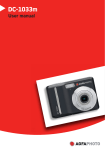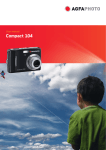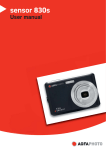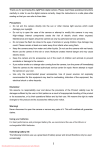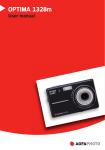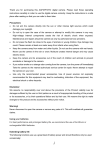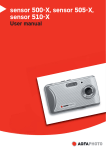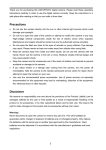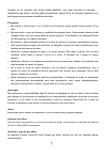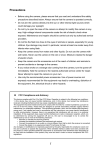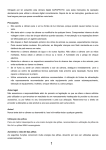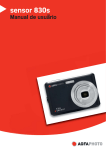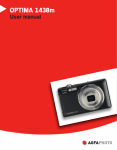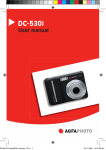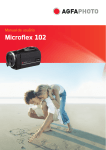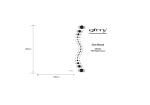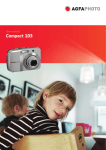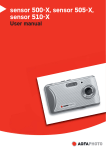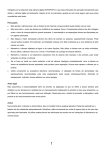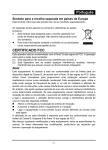Download AgfaPhoto DC-833m User manual
Transcript
DC-833m
User manual
Thank you for purchasing this AgfaPhoto digital camera. Please read these operating instructions
carefully in order to use the digital camera correctly. Keep the instructions in a safe place after
reading so that you can refer to them later.
Precautions
•
Do not aim the camera directly into the sun or other intense light sources which could
damage your eyesight.
•
Do not try to open the case of the camera or attempt to modify this camera in any way.
High-voltage internal components create the risk of electric shock when exposed.
Maintenance and repairs should be carried out only by authorized service providers.
•
Do not press the flash too close to the eyes of animals or young children. Eye damage may
result. Please remain at least one meter away from infants when using flash.
•
Keep the camera away from water and other liquids. Do not use the camera with wet hands.
Never use the camera in the rain or snow. Moisture creates internal danger and may cause
electric shock.
•
Keep the camera and its accessories out of the reach of children and animals to prevent
accidents or damage to the camera.
•
If you notice smoke or a strange odor coming from the camera, turn the power off immediately.
Take the camera to the nearest authorized service center for repair. Never attempt to repair
the camera on your own.
Use only the recommended power accessories. Use of power sources not expressly
recommended for this equipment may lead to overheating, distortion of the equipment, fire,
electrical shock or other hazards.
Disclaimer
We assume no responsibility over and above the provisions of the Product Liability Law for
damages suffered by the user or third parties as a result of inappropriate handling of the product
or its accessories, or by their operational failure and by their use. We reserve the right to make
changes to this product and its accessories without prior notice.
Warning!
Never disconnect to open the camera or remove any parts of it. This will invalidate all guarantee
claims.
i
Using your batteries
For best performance and prolonged battery life, we recommend the use of AA lithium or
rechargeable Ni-MH batteries.
Extending battery life
The following functions use up a great deal of battery power and should therefore only be used
occasionally:
•
Excessive use of flash
•
Editing images on the camera display
The battery life can be affected by soiling. Please clean the contacts with a clean and dry
cloth before putting the batteries in the camera. Battery performance drops at temperatures
below 5° C (41° F). If you use the camera at low temperatures you should have replacement
batteries to hand and ensure they do not get too cold. Please note: you should not dispose of
cold and seemingly flat batteries because these batteries may work again at room
temperature.
ii
Contents
PRECAUTIONS
I
GETTING STARTED
1
SETTING IMAGE SIZE AND QUALITY
22
USING THE ZOOM FUNCTION
23
USING THE FLASH
24
USING THE MACRO
25
USING THIS MENU
1
USING THE SELF-TIMER & BURST
26
SCOPE OF DELIVERY
2
USING THE APERTURE PRIORITY
27
PARTS OF THE CAMERA
3
USING THE SHUTTER PRIORITY
27
INSERTING THE BATTERIES
5
USING THE MANUAL EXPOSURE
28
LOW BATTERY INDICATOR
5
ABOUT BATTERY TYPE
5
INSERTING THE MEMORY CARD
6
ABOUT CAMERA MEMORY
6
DCF PROTOCOL
6
RECORDING MOVIE CLIPS
SETTING THE MOVIE SIZE
RECORDING AUDIO CLIPS
PLAYING BACK AUDIO CLIPS
RECORDING A VOICE MEMO
SETTING THE DISPLAY LANGUAGE / DATE &
TIME
PLAYING BACK A VOICE MEMO
29
29
30
30
31
31
7
OTHER RECORDING FUNCTIONS
32
9
SETTING THE METERING
32
9
SETTING THE WHITE BALANCE
32
SETTING THE DISPLAY LANGUAGE
7
SETTING THE DATE & TIME
7
USING THE LCD MONITOR
REC MODE
PLAYBACK MODE
10
SETTING THE ISO
33
CHANGING THE LCD STATUS
11
SETTING THE EXPOSURE
33
SETTING THE AEB
33
SETTING THE HIGHLIGHT
33
SETTING THE SHARPNESS
34
12
SETTING THE PHOTO EDIT
34
12
SETTING DATE STAMP
34
13
SETTING STABILIZER
35
SWITCHING BETWEEN REC MODE AND
SETTING FACE TRACKING
35
PLAYBACK MODE
13
SETTING PHOTO FRAME
35
SELECTING THE REC MODE
13
SELECTING THE ASM MODE
14
PLAYBACK
36
PLAYING BACK IMAGES
36
BASIC OPERATION
TURNING THE POWER ON AND OFF
POWER SAVING FUNCTION
CHANGING THE MODE
USING THE MENUS
12
15
REC MENU
15
SETUP MENU
17
PLAYING BACK MOVIE CLIPS
36
MAGNIFYING & TRIMMING STILL IMAGES
BASIC RECORDING
RECORDING STILL IMAGES
USING THE Q MODE
20
37
20
VIEWING IN THUMBNAIL
38
PLAYING A SLIDE SHOW
38
DELETING FILES
21
iii
39
DELETING A SINGLE FILE
39
DELETING MULTIPLE FILES
40
DELETING ALL FILES
40
PROTECTING A SINGLE FILE
41
PROTECTING ALL FILES
41
PROTECTING MULTIPLE FILES
42
EDITING IMAGES
43
ROTATING STILL IMAGES
43
CHANGING THE IMAGE SIZE
43
CHANGING THE IMAGE WITH EFFECTS 44
CHOOSING THE IMAGE WITH PHOTO
FRAME
44
COPYING THE FILES
45
SETTING THE DPOF
46
CHOOSING A STARTUP IMAGE
47
MAKING CONNECTIONS
48
CONNECTING THE CAMERA TO A TV
48
CONNECTING THE CAMERA TO A PC
49
USING THE CARD READER
49
CONNECTING THE CAMERA TO A
COMPUTER WITH THE USB CABLE
49
APPENDIX
50
ABOUT THE FOLDER & FILE NAME
50
FOLDER STRUCTURE
50
FILE NAMING
50
TROUBLESHOOTING
51
SPECIFICATIONS
52
FUNCTION AVAILABLE LIST
53
CUSTOMER CARE
59
iv
Getting Started
Using This Menu
Getting Started
This section contains information you should know before using this camera.
Basic Operation
This section explains all recording features of this camera.
Basic Recording
This section explains how to record still images, movies, and audio files.
Other Recording Functions
This section explains common operations about recording images.
Playback
This section explains playback, delete, and edit functions of still images, movies and
audio files.
Making Connections
This section tells you how to connect this camera to a computer or TV.
Appendix
This section describes the troubleshooting and the camera specification.
The meanings of the symbols used in this user's manual are explained below:
Caution
This indicates cautions that should be read before using these
functions.
Tips
This indicates the useful information when using this camera.
This indicates the reference page.
1
Scope of delivery
AgfaPhoto DC-833m
USB Cable
AV Cable
Soft Case
Strap
2 x AA Batteries
Software Installation
CD-ROM
Quick Start Guide
Caution
y
Note that the shape of the charger plug depends on the area where you
purchased the camera.
y
Do not swing the camera around by the strap.
2
Parts of the Camera
1. Flash (
page 24)
2. Microphone
3. Lens
4. Self-timer Lamp
5. Zoom Button (
y
Thumbnail (
y
Playback Zoom
(
page 23)
page 38)
page 37)
6. Playback Button
(
page 13)
7. Menu Button (
page 15)
8. Operation Lamp
9. Mode Button (
page 13)
10. ASM Button (
page 14)
y
Delete Button (
11. LCD Monitor (
page 39)
page 9)
12. SET/DISP Button
(
page 11)
13. Flash Button (
14. Macro Button (
3
page 24)
page 25)
15. Strap Ring
16. Shutter Button
(
page 20, 29)
17. Power Button (
page 12)
18. Speaker
19. USB/AV Terminal
(
page 19, 49)
20. Battery Cover (
21. Tripod Socket
4
page 5)
Inserting the Batteries
1
Open the battery cover.
y
Slide the battery cover in the
direction indicated by the
arrow.
2
Insert the batteries.
y
Insert two AA-size batteries
with the positive (+) and
negative (-) poles matching
the directions indicated
inside the battery room.
3
Close the battery cover.
Low Battery Indicator
A low battery indicator
appears on the LCD screen when the batteries are nearly
exhausted. Batteries should be replaced promptly when the low battery indicator
appears.
Caution
y
Risk of explosion if battery is replaced by an incorrect type dispose of used
batteries according to the instructions.
y
Be sure to turn off the camera power before insert or remove batteries.
y
It is recommended to use the provided battery. For other compatible batteries,
please refer to Battery types. (
page 19). Use of any other type battery is not
recommended.
y
Replace all batteries at the same time. Never mix old and new batteries.
y
Remove batteries if you will not be using them for a long time.
y
The camera body may feel warm after extended use. This is normal.
About Battery Type
After replacing the batteries, please check the Battery Type in the setup menu (
page 19).
5
Inserting the Memory Card
You can use SD cards with this digital camera. The memory card slot is located beneath
the battery cover, adjacent to the battery compartment.
1
Open the battery cover.
y
Slide the battery cover in the
direction indicated by the
arrow.
2
Insert the card.
y
Insert the card with the label
facing up and the arrow
pointing in.
Tips
y
To remove the card, gently press on the edge of the card and release it. Pull the
card out and close the battery cover.
3
Close the battery cover.
Caution
y
It may cause damage to the card if removed while the camera is on.
y
Do not touch the connection terminals on the back side of the card.
About Camera Memory
This camera is equipped with internal memory. If the memory card is not inserted in the
camera, all images and movie clips recorded by the camera will be stored in the internal
memory. If the memory card is inserted, images and movie clips are stored on the
memory card.
DCF Protocol
The DCF protocol defines the format for image file data as well as the directory structure
for the memory card. Images that are taken by a DCF camera can be viewed on
DCF-compatible cameras from other manufacturers.
6
Setting the Display Language / Date & Time
When using the camera for the first time after purchasing, be sure to choose a language
and set the date & time before using the camera.
Setting the Display Language
1
Turn the power on, and set the camera
to the Setup Menu (
2
Select [
y Press
page 17).
Language].
or
to select
[LANGUAGE] then press
or the
SET button to launch the submenu.
3
Select a language.
y
Press
or
to select a language and press
or the SET button to
apply the setting.
4
Press the MENU button to close the menu.
Setting the Date & Time
1
Turn the power on, and set the camera
to the Setup Menu (
2
Select [
y Press
page 17).
Date & Time].
or
to select [Date &
Time] then press
or the SET
button to launch the submenu.
3
Set date and time.
y
Press
or
to change the value of the cursor located. Press
to move the cursor between settings.
Tips
y
Holding down
y
For date stamp setting (
or
changes the values continuously.
page 34).
7
or
4
Apply the setting.
y
After adjusting the settings, press the SET or the MENU button to apply the
setting.
Caution
y
If the batteries are removed for longer than 48 hours, the date and time will need to
be re-set.
8
Using the LCD Monitor
The LCD monitor is used to compose images while recording, adjust settings and replay
images. The following indicators may appear on the LCD monitor while recording or
playing back images.
REC mode
13
White balance (
page 32)
14
Shutter speed (
page 20)
15
Shake warning (
page 20)
16
Aperture value (
page 20)
17
Face tracking (
Shots remaining
18
Exposure (
7
Battery (
19
Focus area (
page 20)
8
Storage media
20
Date stamp (
page 34)
9
Stabilizer
21
AEB (
10
Metering (
22
Sharpness (
11
ISO (
23
Quality (
12
Histogram
24
Resolution (
1
Recording mode (
2
Flash (
3
Macro (
4
Self-timer / Burst (
5
Zoom indicator (
6
page 13)
page 24)
page 25)
page 26)
page 23)
page 5)
page 32)
page 33)
9
page 35 )
page 33)
page 33)
page 34)
page 22)
page 22)
PLAYBACK mode
7
Recording info (
8
Histogram
9
Captured date & time
File number / Total
10
Voice memo control (
5
Battery (
11
DPOF (
6
Storage media
12
Resolution (
1
Playback mode (
2
Protect (
3
Voice memo (
4
page 13)
page 41)
page 31)
page 5)
page 11)
page 31)
page 46)
page 22)
Caution
y
Some information may not display correctly if you display images captured by
other camera model.
10
Changing the LCD Status
Press the SET/DISP button changes the LCD status as shown below:
REC mode
(A) OSD on
(B) Full OSD
(C)Guide line
(D) OSD off
Tips
y
Use the “Guide line” to compose images easily before shooting images.
PLAYBACK mode
(A) OSD on
(B) Full OSD
Caution
y
You cannot change the LCD status in the following situation:
。
Manual exposure
。
Recording movie clips or audio files
。
Playing movie clips or audio files
。
Playing the slideshow
。
Viewing in thumbnail
。
Trimming a still image
11
(D) OSD off
Basic Operation
Turning the Power On and Off
1
Press the POWER button (n) to turn on
the camera in the REC mode.
y
The power turns on, the lens extends
and the LED lights in green.
Press the PLAYBACK button (o) to turn
on the camera in the PLAYBACK mode.
y
The power turns on, and an image
displays on the LCD monitor (p).
2
Press the POWER button (n) again to turn the power off.
y
The power turns off, the lens retracts and the LED turns off.
Tips
y
You can turn on the camera without the start-up and operating sound by
pressing and holding the POWER (n) or the PLAYBACK (o) button over 1.5
seconds.
y
Switch between REC mode and PLAYBACK mode (
page 13).
Power Saving Function
For saving the battery power, the LCD monitor automatically turns off 1 minute after the
last control accessed (factory-preset setting). Press any button other than the power
button to turn on the LCD monitor. You can change the power save setting in Setup
menu (
page 18).
After the power saving function has been active for 1 minute, the power will turn off
completely. Press the POWER (n) or the PLAYBACK (o) button to restore the power.
The power save feature will not activate in the following situation:
y
Recording movie clips or audio files
y
Playing movie clips or audio files
y
Playing a slideshow
y
Connecting the camera to a computer or printer with the USB cable
12
Changing the Mode
You can record images and voices in the REC mode and use the PLAYBACK mode to
replay, delete, or edit images on the LCD monitor.
Switching between REC mode and PLAYBACK mode
In REC mode, press the PLAYBACK button
(n) to switch to the PLAY mode.
In PLAY mode, press the PLAYBACK (n)
or the MODE (o) button to switch to the
REC mode.
Selecting the REC mode
1
Set the camera to the REC mode
(
2
page 13).
Launch the mode palette.
y Press the MODE button (o) to
show the scene mode palette.
3
Select a mode.
y
Use the four-way control to select a desired mode and press the SET
button to confirm the setting.
Display
Title
Description
Program
The camera makes settings suitable for the shooting conditions.
Movie
Voice REC
For recording movie clips.
For recording audio.
Q Mode
Allows beginners to take pictures easily.
Portrait
Blurring the background to focus on the subject.
13
Display
Title
Landscape
Sunset
Description
Used for the wide scenic views.
Enhance the red hue for recording sunset images.
Backlight
Shooting the image of backlight object by changing metering.
Smile
Capture
Capture the most brilliant smile of characters.
Kids
Night Scene
Fireworks
Take a still image to capture moving kids.
Shooting the subject while keeping the background night scenery.
Slow shutter speed to take fireworks exploding.
Snow
Used for the beach or snow scenes.
Food
Higher saturation makes food more appetizing.
Building
Text
Enhance the edges of the subject.
Enhance the black & white contrast.
Selecting the ASM mode
1
Set the camera to the REC mode
(
page 13).
y It cannot be switch to ASM mode
while in Movie or Voice REC
mode.
2
Launch the ASM mode.
y Press the ASM button (n) to
toggle between Aperture
Priority, Shutter Priority, Manual
Exposure mode.
y
For detail operation (
page
26).
14
Using the Menus
When a menu is displayed, the four-way control and the SET button are used to make
the desired settings.
REC menu
1
Turn the power on, and set the
camera to the REC mode
(
2
page 13).
Open the REC menu.
y
Press the MENU button (n)
to display the menu.
3
Select an item.
y
Press
or
(o) to
select a menu item.
4
Change the setting.
y
5
Press
or
(o) to change the setting.
Press the MENU (n) or the SET (o) button to save the settings and close
the menu.
REC menu list (Still Image)
Menu Item
Available Setting
Resolution
/
/
/
/
Page
/
/
22
Quality
/
/
22
Metering
/
/
32
Auto /
/
White Balance
ISO
/
/
/
/
Auto / ISO 50 / ISO 100 / ISO 200 / ISO 400 / ISO
32
33
800 / ISO 1600
Exposure
33
...
Drive Mode
Off /
AEB
Off /
Highlight
Off /
/
/
/
26
33
/
/
15
33
Sharpness
/
34
/
Effect
Off / B&W / Sepia / Negative / Red / Green / Blue
34
Date Stamp
Off / Date / Date & Time
34
Stabilizer
Off / On
35
Face Tracking
Off / On
35
Photo Frame
Off / Frame 1 ~ 10
35
Digital Zoom
Off / On
REC menu list (Movie)
23
Menu Item
Available Setting
Movie Size
/
Metering
/
/
Auto /
/
White Balance
Page
29
/
32
/
16
/
/
/
32
Setup menu
1
Turn the power on, and set
the camera to the REC or
PLAYBACK mode
(
2
page 13).
Press the MENU button (n)
to open the REC or
PLAYBACK menu.
y
The menu displays
depends on whether you
are in the REC mode or
the PLAYBACK mode.
3
Open the Setup menu.
y
Press four-way control (o) to select SETUP (
) and then press the SET
(o) button to display the Setup menu.
4
Select an item.
y
Press
or
(o) to select a menu item and then press
or the SET
(o) button to launch the submenu.
5
Change the setting.
y
Press
or
(o) to select an option and press
button to apply the setting.
6
Press the MENU (n) button to close the menu.
17
or the SET (o)
Setup menu list
Menu Item
Sounds
Functions
[Shutter]:
Sets the shutter sound on and off.
[Start-up]:
Sets a type of the start-up sound.
[Beep]:
Sets the operation sound on and off.
[Volume]:
Adjusts the volume of the shutter sound, start-up
sound, beep and playback sound.
[Off]:
The captured image will not automatically display after
shooing.
[1 sec.]:
Auto Review
The captured image will display for 1 second after
shooting.
[3 sec.]:
The captured image will display for 3 seconds after
shooting.
[5 sec.]:
The captured image will display for 5 seconds after
shooting.
[1 min.] / [3 min.] / [5 min.]:
For power consumption, the camera is turned off automatically for
Power Save
a period of time.
y
The power save feature will not activate in some situation
(
Date & Time
page 12).
Sets the date & time (
page 7).
Select a language for display menus and other information from
the following 21 languages: (
[English]: English
[Deutsch]: German
Language
page 7)
[繁體中文]: T. Chinese
[Italiano]: Italian
[Español]: Spanish
[Nederlands]: Dutch
[Français]: French
[Magyar]: Hungarian
[Português]: Portuguese
[Türkçe]: Turkish
[Čestina]: Czech
[Svenska]: Swedish
[Polski]: Polish
[Rumänisch]:Romanian
[Русский]: Russian
[]يبرع: Arabic
[Ελληνικά]: Greek
[
]:Thai
[日本語]: Japanese
[한국어]: Korean
[简体中文]: S. Chinese
Use this function if the camera experiences a “Folder cannot be
File No.
created” error or if you want to restart numbering, for example,
after erasing all files.
[Series]:
Store the latest used file number no matter deleting
18
Menu Item
Functions
files or inserting a new memory card.
[Reset]:
Reset file numbering each time the memory card is
changed.
y
Resetting the file number is useful for avoiding the file name
duplication when images are downloaded to a computer
(
page 50).
You can review images on a television with a supplied AV cable
page 48). TV Out should be set to either NTSC or PAL
(
TV Out
depending on your region.
[NTSC]:
America, Japan and others
[PAL]:
Europe, Oceania and others
[Computer] / [Printer]:
USB
Sets the USB mode to connect the camera with a printer or
computer (
S.Image
page 49).
Sets a recorded image as the start-up image (
page 47).
To erase all data stored in the memory card if you are using a
card, or all data stored in the internal memory if there is no card
inserted.
Format
y
A “BUSY...PLEASE WAIT” message displays and the memory
card is starting format.
y
A “COMPLETED” message displays when finish formatting.
y
All data will be deleted including protected files. Be sure to
download important files to your computer before formatting.
To ensure the camera displays battery level correctly, set the type
Battery Type
to match the batteries used.
Alkaline / NiMH / Lithium / Qxyride
Resets the entire menu and button operation settings to initial
default.
The following settings do not change after Reset All:
Reset All
y Date & Time setting
y Language setting
y TV out setting
y Battery Type
19
Basic Recording
Recording Still Images
1
Turn the power on, and set the
camera to the REC mode
(
2
page 13).
Compose the subject on the
monitor.
y
Aim the focus area (n) to the
subject that you want to take.
3
Half press the shutter button to focus the image.
y
The focus area (n) becomes green while in focus, then shutter speed (o),
aperture value (p) and ISO value (q) are displayed.
y
If the shutter speed is slow or the possibility that image may be blurred, the
shake warning icon
may appear on the LCD monitor. To avoid this, use a
tripod to stabilize the camera when recording images.
4
Take a picture.
y
Press the shutter button fully to
take a picture.
Caution
y
Make sure that your fingers or
the wrist strap does not block the
lens.
20
Using the Q mode
The Q mode provides a simplified camera
interface. Larger icons and fewer controls
make it easier to take pictures anytime,
especially for the beginners and elder
users.
You can use only the basic settings in the Q
mode:
Flash: Auto / Red eye / Force on / Slow sync / Force off
Button
Macro: Off / On
SET/DISP: OSD on / Guide line / OSD off
Resolution: 8M / 3:2 / 16:9 / 6M / 4M / 2M / VGA
Drive Mode: Off / 2 sec. / 10 sec. / Double / Burst
Stabilizer: Off / On
Menu
Face Tracking: Off / On
Photo Frame: 10 frames can be selected
Beep: Off / On
Auto Review: Off / 1 sec. / 3 sec. / 5 sec.
Rest of settings will not be controlled as below:
y
Quality: S.Fine
y
Highlight: Off
y
Metering: Multi
y
Sharpness: Normal
Fixed setting
y
White balance: Auto
y
Effect: Off
(*)
y
ISO: Auto
y
Date Stamp: Date & Time
y
Exposure: Auto
y
Digital Zoom: Off
y
AEB: Off
y
Shutter sound
y
File No.
y
Start-up sound
y
TV out
y
Power save
y
USB
y
Date & Time
y
Start-up image
y
Language
Utility setting
(**)
(*)Fixed setting: Settings are fixed in Q mode.
(**)Utility setting: Use the same setting as last mode used.
21
Setting Image Size and Quality
You can select lower image resolution and quality to decrease the image size to capture
more images. Choose a suitable setting according to the desired image quality and
purpose. For details, see page 15.
Resolution Values
Image Size
3264 x 2448
Print Size
Printing larger than A4-size.
Larger
Printing to postcards or attaching to e-mail.
Smaller
3264 x 2176
3264 x 1840
2816 x 2112
2272 x 1704
1600 x 1200
640x480
Quality Values
Compression
Purpose
Super Fine
Shoot higher quality images.
Fine
Shoot normal quality images.
Normal
Shoot for more images.
22
Higher Quality
Lower Quality
Using the Zoom Function
Your camera has a combination of optical and digital zoom functions that allows you to
zoom in on far away subjects or zoom out for a wide angle shot.
The optical zoom is achieved by mechanically adjusting the lens of the camera. The
digital zoom enlarges or shrinks the image using a software process.
1
Select the zoom setting, and
point the camera at the subject.
2
Press the zoom button (n) to
compose the image.
[W]: zoom out for a wide-angle
shot.
[T]: zoom in for a telephoto shot.
y
When the zoom button is
pressed, the zoom bar appears
on the LCD monitor.
y
When the optical zoom (o)
factor is at maximum, zooming
stops temporarily. Press the
[T] again, the camera switches
to the digital zoom (p)
automatically and zooming
continues.
y
The digital zoom (p) will not
activate in movie recording.
3
Press shutter button to take a
picture.
Tips
y
Digital zoom works by enlarging the center portion of an image through a
software interpolation process.
y
The digital zoom is used to achieve magnification levels up to approx. 4 times.
23
Using the Flash
The flash is not only for taking pictures when there is insufficient light, but also when the
subject is in shade or in backlight conditions. Press the flash button to cycle your camera
through the various flash modes. The flash will not activate when continuous shooting or
movie recording.
1
Turn the power on, and set the camera
to the REC mode (
2
page 13).
Press the flash button (n) to change
the flash mode.
y
Each time the flash button is
pressed, the flash icon (o) changes.
Auto flash:
Flash fires automatically when
shooting conditions require extra
lighting.
Red-eye reduction:
Flash strobes to let the subject’s
eyes adjust to the flash, then
fires again to take the actual
image. Your camera will detect
the subject brightness and use
the flash only when required.
Force on:
Flash fires every time you take a photo, regardless of lighting conditions.
Slow sync:
Flash fires with a slow shutter speed.
Force off:
The flash never fires even in dark situation.
3
Press shutter button to take a picture.
Caution
y
The flash charging time may increase when the battery is low.
y
The available flash settings are limited depending on the REC mode you selected
(
page 53).
24
Using the Macro
Your camera is equipped with a macro function that allows you to focus on very close
subjects. In macro mode you can focus on subjects 15 cm from the lens when in the
maximum wide angle setting and 40 cm in the maximum telephoto setting.
1
Turn the power on, and set the
camera to the REC mode
(
2
page 13).
Press the macro button (n)
enters the macro mode.
y
The macro icon (o) displays in
the LCD monitor.
y
To leave the macro mode,
press the macro button (n)
again.
3
Press shutter button to take a
picture.
Tips
y
Distances referred to measure the distance between the camera lens surface
and the subject.
25
Using the Self-timer & Burst
Use the self-timer to set a delay from the time the shutter button is pressed to the time
the image is shot. Use the burst to record continuous still images shooting.
1
Turn the power on, and set the camera
to the REC mode (
2
page 13).
Open the REC menu (
y
Use
or
page 15).
to select [Drive mode]
from the REC menu.
3
Change the setting.
y
Press
or
to select a drive
mode, then press the SET button.
Off:
Record a single image.
2 sec.:
The shutter release will be delay for 2 seconds.
10 sec.:
The shutter release will be delay for 10 seconds.
Double:
Record two images in a shot after pressing the shutter release button 10
and 12 seconds.
Burst:
Keep pressing the shutter button fully to take continuous shooting.
Release the shutter button to stop shooting.
4
Press shutter button to take a picture.
Tips
y
When using the self-timer function, be sure to use a tripod or place the digital
camera on a level, stable surface.
26
Using the Aperture Priority
In this mode, you can set an aperture value to match the brightness. A higher aperture
value brings the background out of focus. Selecting a lower aperture value allows you to
soft the background.
1
Turn the power on, and set the
camera to the Aperture Priority
(
2
page 14).
Adjust the aperture value by
pressing
3
or
button.
Press shutter button to take a
picture.
Tips
y
The larger the aperture value the smaller the lens opening, allowing less light to
enter the camera.
Using the Shutter Priority
In this mode, you can set a shutter speed to match the brightness. Faster shutter speeds
allow you to take a sharp picture of a moving subject while slower speeds create a trail
effect and allow you to shoot without a flash in dark areas.
1
Turn the power on, and set the
camera to the Shutter Priority
(
2
page 14).
Adjust the shutter speed by
pressing
3
or
button.
Press shutter button to take a
picture.
27
Using the Manual Exposure
You can manually set the shutter speed and aperture to achieve a particular effect.
1
Turn the power on, and set the
camera to the Manual Exposure
(
22
page 14).
Use the SET button to switch
between aperture value and
shutter speed control. Press
or
3
to adjust the setting.
Press shutter button to take a
picture.
y Press the shutter button halfway,
the difference between the
standard exposure and the
selected exposure appears in
red.
28
Recording Movie Clips
1
Turn the power on, and set the
camera to the Movie mode
(
2
page 13).
Compose the subject on the
monitor.
y
Aim the focus area (q) to the
subject that you want to take.
y
The LCD monitor displays the
available recording time (p).
3
Start recording.
y
Press the shutter button (n) to
start recording.
y
Using the zoom button (o) to
adjust the image size.
y
The White Balance is set and
locked to the settings of the first
frame
Caution
4
y
Sound cannot be recorded while pressing the zoom button..
y
The digital zoom cannot be used in Movie mode.
Finish recording.
y
Press the shutter again to end recording.
y
The camera will stop recording automatically when the memory capacity
has been reached.
Setting the Movie Size
Movie Size and Frame Rate
Resolution
Frame Rate
720 x 400
640 x 480
Higher Quality
30 frames/sec.
Lower Quality
320 x 240
29
Recording Audio Clips
1
Turn the power on, and set the camera to the Voice REC mode
(
2
page 13).
Press the shutter button to start recording.
y The voices are recorded from the microphone of the camera. Be careful to
avoid touching the microphone while recording.
3
Press the shutter button again to end recording.
y
The camera will stop recording automatically when the memory capacity
has been reached.
Playing Back Audio Clips
1
Turn the power on, and set the
camera to the PLAYBACK mode
(
2
page 13).
Press
or
to select the audio
clip that you want to playback.
3
Start playing back.
y
Press
to start playing the audio clip.
y
Press
to stop the audio clip, or press
paused, press
again to resume.
30
to pause it. When audio clip
Recording a Voice Memo
You can add a voice memo to the still images after you record it.
1
Turn the power on, and set the camera
to the PLAYBACK mode (
2
Press
or
page 13).
to select a still image
that you want to add a voice memo.
y
If the image already has the voice
memo recorded, the
appears on
the LCD monitor. The new recording
will replace the previous one.
3
Open the PLAYBACK menu.
y
4
Press the MENU button, using four-way control to select Voice Memo (
and press the SET button.
Press the SET button to start recording for 30 seconds.
y
Press the SET button again to end recording.
Caution
y
The voice memo cannot be added to a movie clip or a protected image.
y
You cannot delete only the voice memo. When you delete the image, the
attached voice memo is also deleted.
Playing Back a Voice Memo
1
2
3
Turn the power on, and set the camera to the PLAY mode (
Press
or
page 13).
to select the image that has the voice memo recorded.
Start playing back.
y
Press
to start playing the voice memo.
y
Press
to stop the voice memo, or press
memo paused, press
again to resume.
31
to pause it. When voice
)
Other Recording Functions
Setting the Metering
There are 3 different light metering options available on your camera.
Option
Description
Light is measured from the entire shooting screen, but gives
more importance to the values near the center.
Selects an exposure based on readings from multiple points in
the subject area.
Selects an exposure based on a single reading taken from the
center of your picture.
Setting the White Balance
Adjust the white balance to match different light sources such as sunlight, incandescent
(tungsten) lighting or, fluorescent lighting.
Option
Description
Automatically corrects white balance. Ideal for general
photography.
Adjusts for bright sun conditions, or natural light conditions.
Adjusts for cloudy days or twilight conditions.
Adjusts for normal indoor lighting conditions. Corrects the
orange hue of household light bulbs. Ideal for indoor photos
under tungsten or halogen lighting without a flash.
Adjusts for fluorescent lighting. Corrects the green hue of
fluorescent lighting. Ideal for indoor photos under fluorescent
lighting without a flash.
For more accurate adjustment or when the light source cannot
be specified.
Tips
y
Point the camera at a white piece of paper or similar object under the lighting
conditions for which you want to set the white balance, and then press the
Shutter button.
32
Setting the ISO
With the initial settings, the ISO sensitivity is automatically set according to the
brightness of the subject.
Option
Auto
Description
Sets the ISO sensitivity automatically.
ISO 50
Sets the sensitivity to ISO 50 equivalent.
ISO 100
Sets the sensitivity to ISO 100 equivalent.
ISO 200
Sets the sensitivity to ISO 200 equivalent.
ISO 400
Sets the sensitivity to ISO 400 equivalent.
ISO 800
Sets the sensitivity to ISO 800 equivalent.
ISO 1600
Sets the sensitivity to ISO 1600 equivalent.
Tips
y
Higher ISO speeds increase the image noise. To take clean images, use as low
an ISO speed as possible.
Setting the Exposure
Set the exposure value manually to compensate for unusual lighting conditions such as
indirect indoor lighting, dark backgrounds, and strong backlighting.
Setting the AEB
Sets the auto exposure bracketing (AEB) to shoot 3 continuous images, each with a
different exposure setting: correctly exposed, underexposed, and overexposed.
Setting the Highlight
Make the subject stand out from its surroundings. The subject will be in focus in three
different ranges:
/
/
Tips
y
The Photo Frame and Face Tracking cannot be used as using the Highlight.
33
Setting the Sharpness
You can select whether you want the image to have sharp or soft outlines.
Option
Description
The edges of the image are emphasized. The edges will
become sharp, but noise may occur in the recording image.
The edges of the image are sharp. This is suitable for printing.
The edges of the image are softened. This is suitable for editing
images on PC.
Setting the Photo Edit
You can add special effects to your images in Record mode or in Playback mode.
Option
Off
Description
No effect is added to the image.
Red eye removal. (Playback only)
B&W
Convert image to black & white.
Sepia
Recorded image will be stored in a sepia tone.
Negative
Opposite what they were in the original image.
Mosaic
Add mosaic tiles to the images. (Playback only)
Red
The image becomes reddish.
Green
The image becomes greenish.
Blue
The image becomes bluish.
Setting Date Stamp
The Date Stamp function can be used to add a date to your pictures as you take them.
Option
Off
Date
Date & Time
Description
Do not add the recorded date & time to printed images.
Only add the recorded date to printed images.
Add the recorded date & time to printed images.
34
Setting Stabilizer
With more sensibility and faster shutter speed to bright up the pictures, effectively
prevent blur image caused by hand shack or target movement, one can take good
pictures with little effort.
Setting Face tracking
After initializing face tracking function, the lens will lock the main character in the picture
and follow the movements. Also use auto digital zoom technology to retract and extract
zoom lens that allows you to become the focus of lens.
Tips
y
Pressing the shutter halfway showing green AF area means focus is complete.
y
Face tracking is powered by Arcsoft.
y
Under some environmental influences, face tracking function may be limited.
y
The Highlight and Photo Frame cannot be used as using the Face Tracking.
Setting Photo Frame
You can add 10 kinds of frames to still images, making them more interesting.
Tips
y
This feature only available with still images (except 3:2 and 16:9).
y
The Highlight and Face Tracking cannot be used as using the Photo Frame.
35
Playback
Playing Back Images
1
Turn the power on, and set
the camera to the PLAYBACK
mode (
y
page 13).
The latest recorded image
appears on the LCD
monitor.
y
If there are no images
stored, a message [No
image] appears.
2
Press the four-way control
(n).
or
y
: displays the previous image.
y
: displays the next image.
Tips
y
Holding down
or
scrolls images in a high speed.
Playing Back Movie Clips
1
Turn the power on, and set the camera to the PLAYBACK mode
(
2
3
page 13).
Press
or
to select a movie clip that you want to playback.
Start playing back.
y
Press
to start playing the movie clip.
y
Press
to stop the movie clip, or press
paused, press
to pause it. When the movie
again to resume.
Tips
y
During movie playing back, press
y
Press the shutter to capture the still image from the movie clip while it had paused.
to fast forward or press
36
to rewind it.
Magnifying & Trimming Still Images
1
Turn the power on, and set the
camera to the PLAYBACK
mode (
2
page 13).
Select an image.
y
Press
or
(p) to select
the image that you want to
magnify or trimming.
y
Only still images can be
magnified and trimmed.
3
Magnify the image.
y Press [T] (n) to magnify the image, and the central portion of the image is
displayed. You can use the arrow button (p) to view different parts of the
magnified image.
y
4
Trim the image.
y
5
Press the MENU button (o) to return to the normal size.
Press the SET button (p) to set the image trimming.
Save the image.
y
Press the SET button (p) again to trim the selected image and save it as a
new one.
37
Viewing in Thumbnail
1
Turn the power on, and set the
camera to the PLAYBACK mode
(
2
page 13).
Press the zoom button [W], a
thumbnail screen is displayed.
3
Use the four-way control to select the desired image, and press [T] or the
SET button to show the selected image in full screen.
Tips
y
You can protect or delete multiple images in thumbnail, see page 40, 42.
Playing a Slide Show
1
Turn the power on, and set the
camera to the PLAYBACK mode
(
2
page 13).
Enter the slide show.
y
Press the MENU button (n),
use the four-way control (o) to
select Slide Show (
) and
press the SET button (o).
3
Change the slide show settings.
y Use the four-way control (o) to set the slideshow interval (
and repeat (
y
4
), effect (
)
).
You can set the interval between 1~10 seconds.
Playing the slide show.
y
Press the SET button (o) to start the slideshow.
y
During the slideshow, press the SET button (o) to pause the slideshow and
press the SET button again to resume.
38
Deleting Files
Deleting a Single File
1
Turn the power on, and set the
camera to the PLAYBACK mode
(
2
page 13).
Open the menu.
y
Press the MENU button (n),
then use the four-way control
(o) to select Delete (
) and
press the SET button (o).
3
Press
or
4
Press
or
5
Press the SET button (o) to delete the image.
y
(o) to select [SINGLE], and then press the SET button (o).
(o) to select the image you want to delete.
Repeat step 4~5 to delete images.
Tips
y
y
To quickly delete the current display image
1.
Select the image you want to delete.
2.
Press the Delete button (p) to show a confirmation.
3.
Press the SET button (o) to delete the current display image.
Protected images cannot be deleted with this function.
39
Deleting Multiple Files
1
Turn the power on, and set the camera
to the thumbnail screen (
2
Open the menu.
y
Press the MENU button, then Press
to select to select Delete
or
(
3
) and press the SET button.
Press
y
4
page 38).
or
to select [Select], and then press the SET button.
The frame of the selected image turns green.
Select multiple images.
y
Use the four-way control to select the image.
y
Press the SET button toggles the
on and off. Repeat this step until all
images that you want to delete are displayed with an icon
5
.
Delete images.
y
Press the MENU button, then select [Yes] and press the SET button. All
selected images will be deleted.
y
To cancel delete, press the MENU button in this step.
Deleting All Files
1
Turn the power on, and set the camera
to the PLAYBACK mode (
2
page 13).
Open the menu.
y
Press the MENU button, then use the
four-way control to select Delete (
y
)
and press the SET button.
You can open the menu in full screen or in thumbnail.
3
Press
4
Press the SET button to delete all unprotected images.
or
to select [ALL], and then press the SET button.
40
Protecting a Single File
1
Turn the power on, and set the camera to the PLAYBACK mode
(
2
page 13).
Open the menu.
y Press the MENU button, then use the four-way control to select Protect
(
) and press the SET button.
3
Press
or
to select [SINGLE], and then press the SET button.
4
Press
or
to select the image you want to protect.
5
Press the SET button to protect the image.
y
y
displays on the LCD monitor.
When the file is locked, the
Repeat step 4~5 to protect images.
y
To unlock the file, press the SET button again in step 5. The
disappear and the file is unlocked.
will
Protecting All Files
1
Turn the power on, and set the camera
to the PLAYBACK mode (
2
page 13).
Open the menu.
y
Press the MENU button, then use
the four-way control to select
Protect (
) and press the SET
button.
y
You can open the menu in full screen
or in thumbnail.
3
Press
y
4
or
to select [Lock all], and then press the SET button.
To unlock all files, select [Unlock all] in this step, then press the SET button.
Press the SET button to protect all images.
41
Protecting Multiple Files
1
Turn the power on, and set the
camera to the thumbnail screen
(
2
page 38).
Open the menu.
y
Press the MENU button, then
Press
or
to select to
select Protect (
) and press
the SET button.
3
Press
y
4
or
to select [Select], and then press the SET button.
The frame of the selected image turns green.
Select multiple images.
y
Use the four-way control to select the image.
y
Press the SET button toggles the
on and off. Repeat this step until all
images that you want to protect are displayed with an icon
5
.
Protect images.
y
Press the MENU button, then select [Yes] and press the SET button. All
selected images will be protected.
y
To cancel protect, press the MENU button in this step.
42
Editing Images
Rotating Still Images
1
Turn the power on, and set the
camera to the PLAYBACK mode
(
2
page 13).
Press
or
to select the image
you want to rotate.
3
Open the menu.
y
Press the MENU button, then use the four-way control to select Rotate (
and press the SET button.
4
Press the SET button to rotate the image.
y
5
Each press rotates the image 90 degrees in clockwise.
Press
or
to select OK, and then press the SET button to finish
rotating.
Changing the Image Size
1
Turn the power on, and set the camera to the PLAYBACK mode
(
page 13).
2
Press
3
Open the menu.
y
Press
y
to select the image you want to resize.
Press the MENU button, then use the four-way control to select Resize
(
4
or
) and press the SET button.
or
to select an option, and then press the SET button.
The resized image will be saved as a new file.
Caution
y
Only a large size image can be resize to a smaller one.
43
)
Changing the Image with Effects
You may use Red Eye Removal remove the red eye caused by flash from original photo.
Or use color filters to save as a new image.
1
Turn the power on, and set the camera to the PLAYBACK mode
(
page 13).
2
Press
3
Open the menu.
y
Press
y
to select the image you want to add the effect.
Press the MENU button, then use the four-way control to select Effect
(
4
or
) and press the SET button.
or
to select an option, and then press the SET button.
The edited image will be saved as a new file.
Choosing the Image with Photo Frame
1
Turn the power on, and set the camera to the PLAYBACK mode
(
2
3
page 13).
Press
or
Open the menu.
y
Press the MENU button, then use the four-way control to select Photo
Fames (
4
to select the image you want to add the photo frame.
Press
or
) and press the SET button.
to select the image you want, then press the SET button to
apply the choice.
y
The edited image will be saved as a new file.
44
Copying the Files
You may copy the data from the camera’s internal memory to the memory card for
convenience.
1
Be sure you have inserted a memory
card into your digital camera. Set
the camera to the PLAYBACK mode.
(
2
page 13).
Open the menu.
y
Press the MENU button, then use
the four-way control to select
Copy to card (
) and press the
SET button.
3
Press
y
or
to select [Single], then press the SET button.
To copy all images to a memory card, select [All].
4
Press
5
Select [Yes] and then press the SET button to start copy.
or
to select the image you want to copy to a card.
y
Repeat step 4~5 to copy other images.
y
Press the MENU button to complete the setting.
45
Setting the DPOF
The Digital Print Order Format (DPOF) setting allows you to select images on the
memory card for printing and specify the number of print copies in advance using the
camera. This is extremely convenient for sending the images to a photo developing
service or for printing on a direct print function compatible printer.
1
Turn the power on, and set the camera
to the PLAYBACK mode (
2
page 13).
Open the menu.
y
Press the MENU button, then use the
four-way control to select DPOF (
)
and press the SET button.
s
3
Press
or
to select [Single], then press the SET button.
y
To set the DPOF setting for all images, select [All] in this step.
y
To reset all DPOF settings to initial default, select [Reset] in this step.
4
Press
5
Set the number of copies.
6
or
to select the image you want to print out.
y
Press
y
The number of copies can be set from 0 to 30.
y
To cancel this image DPOF setting, set the number of copies to 0.
or
to specify the number of copies.
Print the date stamp out.
y
Press SCN button to set the date stamp of current image. Press SCN button
again to turn off date stamp.
y
7
Repeat step 4~6 to other images for printing.
After you finished all image settings, press the SET or MENU button to
apply it.
46
Choosing a Startup Image
1
Turn the power on, and set the camera to the PLAYBACK mode
(
2
page 13).
Open the menu.
y
Press the MENU button, then use the four-way control to select Start-up
Image (
3
Press
) and press the SET button.
or
to select the image you want, then press the SET button to
apply the choice.
y
A message “Completed” appears.
4
Set the camera to the Setup Menu (
5
Press
or
to select Start-up
) then press
Image (
page 17).
or the
SET button.
6
Press
or
to select a desired
option and press the SET button to
apply the setting.
Disable the start-up image.
[Off]:
[System]:
Use camera default image.
[My image]: Use the image that you just specified in step 3.
7
Press the MENU button to close the menu.
Caution
y
The start-up image will not be deleted even if the original image is deleted or
memory formatted.
47
Making Connections
Connecting the Camera to a TV
You can display recorded images on a television with a supplied AV cable.
1
Set the TV out to match the TV system that you are using (
2
Turn off the camera and the TV.
3
Use the supplied AV cable to connect the camera to the TV set.
4
Set the TV input signal to Video In.
y
5
page 19).
Refer to the documentation included with your TV for more information.
Display on TV.
y
Everything that would normally appear on the camera’s LCD screen, such
as photo and video clip playback, slide shows, and image or video capture,
appears on the TV.
48
Connecting the Camera to a PC
There are two ways to download files from the camera’s internal memory or memory
card to a computer:
y
Inserting the memory card into a card reader
y
Connecting the camera to a computer using the supplied USB cable
Using the Card Reader
1
Eject the memory card from the camera
and insert it in a card reader that is
connected to a computer.
2
Open [My Computer] or [Windows
Explorer] and double-click the removable
drive icon that represents the memory
card.
3
Copy images from the card into a directory of your choice on the
computer’s hard disk.
Connecting the Camera to a Computer with the USB Cable
1
Install the USB software driver included
with the bundled CD-ROM.
2
Connect the supplied USB cable to the
computer’s USB port and turn on the
camera.
y
The LCD screen turns off when the
connection to the computer has been
successfully completed.
3
Open [My Computer] or [Windows Explorer]. A “Removable Disk” appears
in the drive list.
4
Double-click the “Removable Disk” icon to view its contents.
y
Files stored on camera are located in the folder name “DCIM”.
49
Appendix
About the Folder & File Name
Your digital camera automatically creates a directory of folders in the internal memory or
memory card that it uses to organize still images, movie clips and other information.
Folder Structure
Folder name begins with a 3-digit number from
100 to 999 and followed by “DICAM”, each folder
holds up to 9999 files. If new files are made, a
new folder named in sequence will be made
automatically.
File Naming
File name begins with “DSCI” and are followed by a 4-digit number that increases in
sequence. File numbering starts from 0001 when a new folder is created.
If the highest folder number is 999 and highest file number exceeds 9999, the camera
will display the warning message “Folder cannot be created”. When it appears, try one of
the following ways:
y
Reset the file number and plug in a new memory card.
y
The folder number and file number are initialized and renumbered from 100 and
0001 respectively.
Caution
y
Do not change the folder and file names in the memory card using your
computer. It may be unable to playback the data using the digital camera.
50
Troubleshooting
Problem
Power does not turn on.
Cause
Solution
Battery is inserted in the wrong Reload battery in the correct
direction.
direction.
Batteries are dead.
Replace or recharge batteries.
The battery compartment door
Make sure the battery
is open.
compartment door is securely
closed.
The camera does not take
The flash is charging.
Wait for the flash to charge.
pictures.
Memory is full.
Insert a new memory card.
Memory card is not formatted
The card may be defective,
correctly.
use a new card.
Image is not recorded when
The Flash is charge.
Wait for the flash to charge.
the shutter button is pressed.
Memory is full.
Insert a new memory card.
The flash does not fire.
Flash is set to OFF.
Set the flash to any mode
except off.
Image is blurry or out of focus.
The camera was moving when
Hold the camera steady when
the image was captured.
shooting picture.
The subject was beyond the
Turn the Macro mode on it the
range within which the camera
subject is within 15 cm or 40
can focus.
cm.
Do not use Macro mode when
shooting distant subjects.
Image is not displayed on the
A memory card with non-DCIF
This camera cannot display
LCD monitor.
images (recorded with other
non-DCIF images.
camera) is loaded.
Recorded images are not
The camera was turned off /
If the battery low indicator
saved in memory.
powered down before the
appears on the LCD monitor,
image was stored in memory.
replace the battery
immediately.
Cannot transfer images to a
USB driver is not installed.
Install the USB driver before
computer after connecting the
you connect the camera to a
USB cable.
computer / turn the camera on.
Card error
The memory card format may
Re-format the memory card to
not be correct.
the FAT format using a card
reader in Windows.
51
Specifications
Sensor
8 mega pixels CCD, Size : 1/2.5 inch
Lens
Focal Length : f = 6.2 ( W ) ~ 18.6 ( T ) mm ,
3X optical zoom, 4X digital zoom
LCD
2.5” LCD display
Focus Range
Normal: 80 cm ~ Infinity , Macro: (W) 15 cm ~ 1 m / (T) 40 cm~ 1 m
Aperture
F/ 2.8 ( W ), 5.2 ( T )
Shutter
8 ~ 1/2000 sec.
File Format
Still Image: EXIF 2.2 compatible format ( JPEG compression ),
DCF compatible. Support DPOF, ( PictBridge available )
Video: AVI , Audio: WAV
Resolution
Still Image: 3264 x 2448 (8M) / 3264 x 2176 (3:2) / 3264 x 1840
(16:9) / 2816 x 2112 (6M) / 2272 x 1704 (4M) / 1600 x 1200 (2M) /
640 x 480 (VGA) , Video: 720 x 400 / 640 x 480 / 320 x 240
Scene Mode
Program /Movie / Voice REC / Sunset / Backlight / Q. Mode /
Landscape / Portrait / Snow / Fireworks / Night scene / Kids / Food /
Building / Text / Smile Capture
Sensitivity
Auto / ISO 50 / ISO 100 / ISO 200 / ISO 400 / ISO 800 / ISO 1600
White Balance
Auto / Daylight / Cloudy / Tungsten / Fluorescent (H) / Fluorescent
(L) / Custom
Exposure Control
-2EV to +2EV in 1/3 step
Metering
Center-weighted / Multi / Spot
Burst
Depends on the capacity of the memory. (no limit)
Self-timer
2 sec. / 10 sec. / Double
Flash
Auto / Red eye reduction / Always on / Slow sync / Always off
Photo Effect
Black & White / Sepia / Negative / Mosaic / Red eye removal / Red /
Green / Blue
Storage
16 MB internal memory / SD Card / SDHC 8 GB
TV system
NTSC / PAL
Power Supply
AA alkaline battery x2
Ambient
Operating: 0° C to 40° C
temperature
Storage: -20 to 60° C
Microphone
Built-in
Speaker
Built-in
Dimension
Camera Body ( W x H x T ): 89.5 x 61.3 x 27 mm
Weight
Camera Body w/o battery: Approx. 125 (g)
*These specifications are subject to change without notice.
52
²
²
²
²
²
²
²
²
²
z
²
²
1/15 ~
1/2000
z
O
²
²
²
²
²
²
²
z
²
²
1~
1/2000
²
²
²
²
²
²
z
²
²
z
²
²
1~
1/2000
z
²
z
²
²
²
O
²
²
z
²
²
1~
1/2000
O
z
z
²
²
²
O
²
²
z
²
²
1~
1/2000
z
²
z
²
²
²
O
²
²
²
²
z
2 sec.
fixed
O
²
²
²
²
²
z
²
²
z
²
²
8~
1/2000
z
²
²
²
²
z
O
²
²
²
z
²
1~
1/2000
z
²
²
z
²
²
O
²
²
²
z
²
1~
1/2000
z
²
²
²
²
²
O
²
²
z
²
²
1~
1/2000
z
²
²
²
z
²
O
²
²
²
²
z
1~
1/2000
z
²
²
²
²
²
z
²
²
²
²
z
1~
1/2000
z
²
²
²
²
²
z
²
²
z
²
²
1~
1/2000
z
²
²
z
²
²
O
²
²
z
²
²
1~
1/2000
z
O
O
O
O
O
O
²
²
z
²
²
8~
1/2000
O
O
²
O
O
²
z
O
O
z
²
²
8~
1/2000
O
O
²
O
O
²
z
²
O
z
²
²
8~
1/2000
O
O
²
O
O
O
z
O
²
z
²
²
1~
1/2000
O
O
O
O
O
O
²
²
Focus
Off
On
Auto
Red eye
Force on
Slow sync
Force off
Aperture value
Shutter speed
Button
²
Infinity Fixed
Scene Mode
²
Continuous AF
One time AF
Shutter & Lens
Still Capture
²
Shutter speed
Function
Mode
Function Available List
²
Macro
53
Flash
Up & Down
²
²
²
²
²
²
²
²
²
²
²
²
²
²
O
O
²
²
²
O
O
O
O
O
O
²
²
²
O
O
O
O
z
²
O
O
O
O
²
²
²
O
O
O
O
z
²
O
O
O
O
O
²
²
²
O
O
O
O
z
²
O
O
O
O
O
O
²
²
²
O
O
O
O
z
²
O
O
O
O
O
O
O
²
²
²
O
O
O
²
z
²
O
O
O
O
O
O
O
²
²
²
O
O
O
O
O
²
O
O
O
O
O
O
O
²
²
²
O
O
O
O
O
²
O
O
O
O
O
O
O
²
²
²
O
O
O
O
z
²
O
O
O
O
O
O
O
²
²
²
O
O
O
O
²
²
O
O
O
O
O
O
O
²
²
²
O
O
O
O
z
²
O
O
O
O
O
O
O
²
²
²
O
O
O
O
z
²
O
O
O
O
O
O
O
²
²
²
O
O
O
O
z
²
O
O
O
O
O
O
O
²
²
²
z
²
²
²
z
²
O
O
O
O
O
O
O
²
²
²
O
O
O
O
O
O
O
O
O
O
O
O
O
²
²
²
O
O
O
O
O
O
O
O
O
O
O
O
O
²
²
²
O
O
O
O
O
O
O
O
O
O
O
O
²
²
²
O
O
O
O
3:2
16:9
6M
4M
2M
VGA
16:9
640
320
S.Fine
Fine
Normal
Center
Multi
Spot
MENU
²
8M
Scene Mode
Still Capture
²
²
²
²
²
²
²
O
O
O
O
O
O
O
O
O
O
Function
Mode
²
Resolution
Movie Size
54
Quality
Metering
z
²
²
z
²
²
z
²
²
z
²
²
z
²
²
z
²
²
z
²
²
O
O
O
O
O
O
²
²
²
²
²
²
²
²
²
²
²
²
²
²
²
²
²
²
²
²
²
²
²
²
²
²
²
²
²
z
O
O
O
O
O
O
O
O
O
O
O
O
O
O
O
O
O
O
O
O
O
O
O
O
1600
²
²
800
²
²
²
z
²
400
²
²
²
²
z
²
²
²
²
²
²
²
²
²
²
²
z
²
²
²
²
²
z
²
²
²
²
²
z
²
²
²
²
²
z
²
²
²
²
²
z
²
²
²
²
²
z
²
²
²
²
²
z
²
²
²
²
²
z
²
²
²
²
²
z
²
²
²
²
²
z
²
²
O
O
O
O
²
O
O
O
O
O
O
O
O
O
O
O
O
O
O
O
O
O
O
Fluor_L
z
²
²
z
Fluor_H
²
²
²
²
²
²
²
²
²
²
z
²
²
²
²
²
²
²
²
²
²
²
²
²
²
²
z
²
²
z
²
²
²
²
²
²
²
²
200
²
²
²
²
z
²
100
²
²
O
²
50
²
²
O
²
Auto
z
Tungsten
O
²
Custom
²
²
Cloudy
²
²
²
Daylight
MENU
²
Auto
Scene Mode
Still Capture
²
²
²
²
²
²
O
O
O
O
²
²
²
²
Function
Mode
²
White Balance
55
ISO
²
²
²
²
²
²
²
²
²
²
²
²
²
²
²
²
²
²
²
O
O
O
O
z
²
²
²
²
²
O
O
O
O
O
z
²
²
²
²
²
²
O
O
O
O
O
z
²
²
²
²
²
z
²
O
O
O
O
O
z
²
²
²
²
²
²
z
²
O
O
O
O
O
z
²
²
²
²
²
²
z
²
O
O
O
O
O
z
²
²
²
²
²
²
z
²
O
O
O
O
O
z
²
²
²
²
²
²
z
²
z
²
²
²
²
z
²
²
²
²
²
²
z
²
O
O
O
O
O
z
²
²
²
²
²
²
z
²
O
O
O
O
O
z
²
²
²
²
²
²
z
²
O
O
O
O
O
z
²
²
²
²
²
²
z
²
O
O
O
O
O
z
²
²
²
²
²
²
z
²
O
O
O
O
O
z
²
²
²
²
²
²
²
²
O
O
O
O
O
z
²
O
O
O
O
O
O
O
O
O
O
O
O
z
O
O
O
O
O
O
O
O
O
O
O
O
O
z
O
O
O
O
O
O
O
O
O
O
O
z
O
O
O
O
0EV
-0.3 ~ -2.0
Off
2 sec.
10 sec.
Double
Burst
Off
On
Off
MENU
Function
²
+0.3 ~ +2.0
Scene Mode
Still Capture
Mode
²
²
²
²
²
²
²
²
²
z
²
O
²
z
²
²
z
²
Exposure
Drive Mode
56
AEB
Highlight
²
²
²
²
²
²
²
²
²
²
²
²
²
²
²
²
²
²
²
²
²
²
²
²
²
²
²
²
z
²
z
²
²
²
²
²
²
O
O
O
O
O
z
²
²
z
O
O
O
O
O
O
O
O
O
O
O
²
z
²
z
O
O
O
O
O
O
O
O
O
O
O
²
z
²
z
²
²
²
²
²
²
O
O
O
O
O
²
z
²
z
²
²
²
²
²
²
O
O
O
z
²
²
z
²
z
²
²
²
²
²
²
O
O
O
O
O
²
z
²
z
O
O
O
O
O
O
O
O
O
O
O
²
z
²
z
O
O
²
O
²
²
O
O
O
O
O
²
z
²
z
²
²
²
²
²
²
O
O
O
O
O
z
²
²
z
²
²
²
²
²
²
O
O
O
O
O
z
²
²
z
O
O
O
O
O
O
O
O
O
O
O
²
z
²
z
O
O
O
O
O
O
O
O
O
O
O
²
z
²
z
²
²
²
²
²
²
²
²
z
O
O
O
O
O
z
O
O
O
O
O
O
O
O
O
O
O
O
O
O
z
O
O
O
O
O
O
O
O
O
O
O
O
O
O
z
O
O
O
O
O
O
O
O
O
O
O
O
O
z
O
O
O
O
O
O
O
O
O
Normal
Soft
Off
B&W
Sepia
Negative
Red
Green
Blue
Off
Date
Date & Time
Off
On
MENU
²
Hard
Scene Mode
Still Capture
²
Function
Mode
²
Sharpness
Effect
57
Date Stamp
Stabilizer
Function
²
²
²
²
²
z
²
O
O
O
O
z
²
O
O
O
O
z
²
O
O
O
O
O
O
O
O
O
O
z
²
O
O
O
O
z
²
O
O
O
O
O
O
O
O
O
O
²
z
z
²
O
O
O
O
O
O
O
O
z
²
O
O
O
O
z
²
O
O
O
O
O
O
O
O
O
O
O
O
O
O
z
²
O
O
O
O
O
z
O
O
O
O
O
z
O
O
O
O
O
z
²
O
O
Face Tracking
Photo Frame
58
Digital Zoom
Frame 1 ~ 10
Off
On
± : Not available.
: Set to [OFF] after power off.
: Disable function.
: Setting is retained even after mode switch or power off.
{ : Available
²
²
: Factory setting z : Default setting
²
²
Off
Scene Mode
²
On
MENU
Still Capture
²
Off
Mode
²
Customer care
More information on the complete AgfaPhoto digital camera product range can be found under
www.plawa.com / www.plawausa.com
Service & Repair (USA/ Canada):
1-866 475 2605
www.plawausa.com
Support Service (USA/ Canada):
[email protected]
Service & Repair Hotline (EU):
00800 752 921 00 (from a landline only)
Service & Support Hotline (Germany):
0900 1000 042 (1.49 Euro/ min. from a German landline only)
Online Service / International contact (Not for USA/ Canada):
[email protected]
Manufactured by
plawa-feinwerktechnik GmbH & Co. KG
Bleichereistraße 18
73066 Uhingen
Germany
AgfaPhoto is used under license of Agfa-Gevaert NV & Co. KG or Agfa-Gevaert NV.
Agfa-Gevaert NV & Co. KG. or Agfa-Gevaert NV does not manufacture this product or provide
any product warranty or support. For service, support and warranty information, contact the
distributor or manufacturer. Contact: AgfaPhoto Holding GmbH, www.agfaphoto.com
59
Disposal of Waste Equipment by Users in Private Households in
the European Union
This symbol on the product or on its packaging indicates that this product must not be
disposed of with your other household waste. Instead, it is your responsibility to dispose of
your waste equipment by handing it over to a designated collection point for the recycling of waste
electrical and electronic equipment. The separate collection and recycling of your waste
equipment at the time of disposal will help to conserve natural resources and ensure that it is
recycled in a manner that protects human health and the environment. For more information about
where you can drop off your waste equipment for recycling, please contact your local city office,
your household waste disposal service or the shop where you purchased the product.
FCC Compliance and Advisory
This device complies with Part 15 of the FCC Rules. Operation is subject to the following two
conditions: 1.) this device may not cause harmful interference, and 2.) this device must accept
any interference received, including interference that may cause unsatisfactory operation. This
equipment has been tested and found to comply with the limits for a Class B peripheral, pursuant
to Part 15 of the FCC Rules. These limits are designed to provide reasonable protection against
harmful interference in a residential installation. This equipment generates, uses, and can radiate
radio frequency energy and, if not installed and used in accordance with the instructions, may
cause harmful interference to radio communication. However, there is no guarantee that
interference will not occur in a particular installation. If this equipment does cause harmful
interference to radio or television reception, which can be determined by turning the equipment
off and on, the user is encouraged to try to correct the interference by one or more of the
following measures.
•
Reorient or relocate the receiving antenna.
•
Increase the separation between the equipment and receiver.
•
Connect the equipment to an outlet on a circuit different from that to which the receiver is
connected.
•
Consult the dealer or an experienced radio/TV technician for help.
Any changes or modifications not expressly approved by the party responsible for compliance
could void the user’s authority to operate the equipment. When shielded interface cables have
been provided with the product or when specified additional components or accessories have
elsewhere been designated to be used with the installation of the product, they must be used in
order to ensure compliance with FCC regulations.
60
Declaration of Conformity
We herewith confirm the following designated product: AgfaPhoto digital camera DC-833m has
been tested and found to comply with the requirements set up in the council directive on the
approximation of the law of members’ states relating to the EMC Directive 2004/108/EC. For the
evaluation regarding to the electromagnet compatibility, the following standards were applied:
EN 55022: 2006, Class B
EN 55024: 1998 + A1: 2001 + A2: 2003
IEC 61000-4-2: 1995+A1: 1998+A2: 2000
IEC 61000-4-3: 2002+A1: 2002
IEC 61000-4-4: 2004
IEC 61000-4-6: 1996+A1:2000
IEC 61000-4-8: 1993+A1: 2000
The device is marked with CE logo.
61
AgfaPhoto is used under license of Agfa-Gevaert NV & Co. KG or Agfa-Gevaert NV. Neither Agfa-Gevaert NV & Co KG nor AgfaGevaert NV manufacture this product or provide any product warranty or support. For service, support and warranty information,
contact the distributor or manufacturer All other brands and product names are registered trademarks of their respective owners.
Product design and technical features can be changed without notice.
AgfaPhoto Holding GmbH, www.agfaphoto.com
Manufactured by plawa-feinwerktechnik GmbH & Co. KG, www.plawa.com



































































